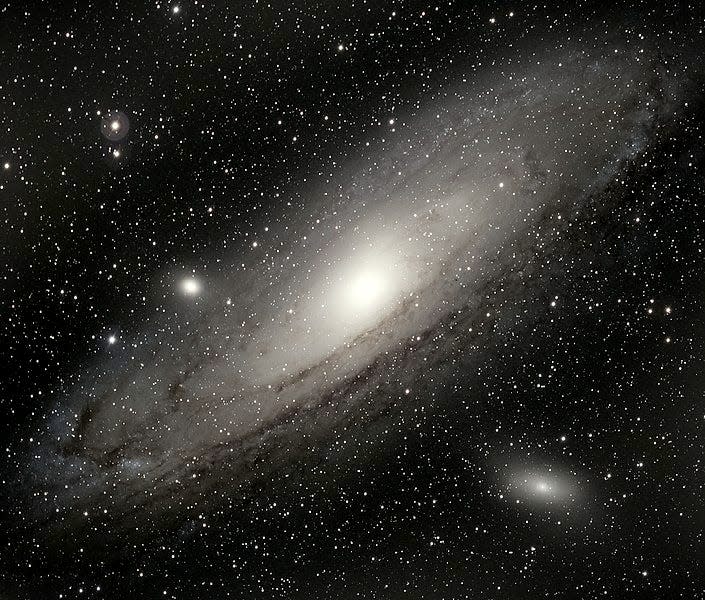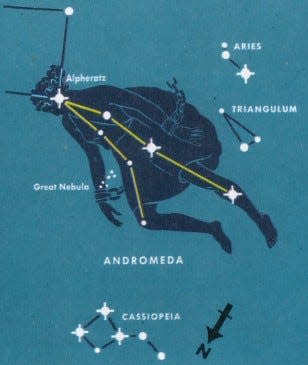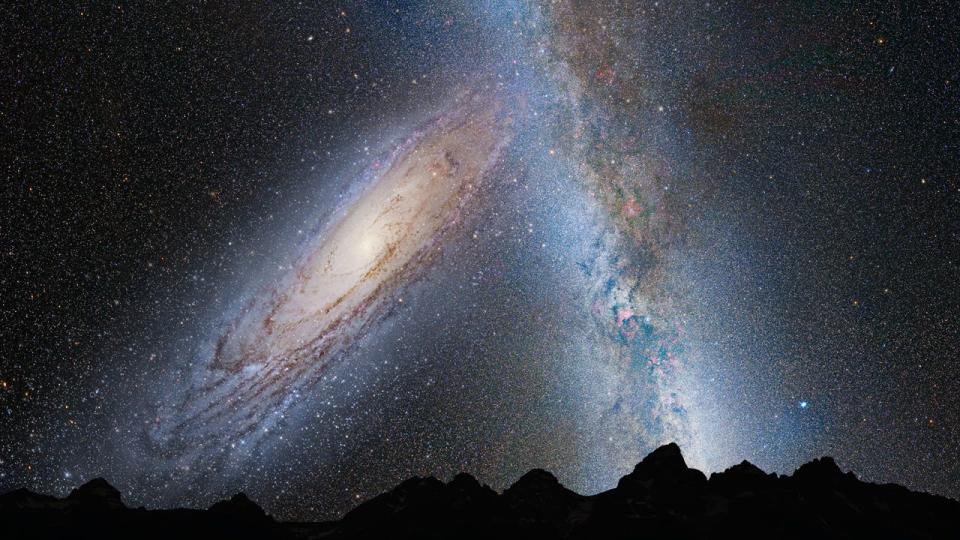LOOKING UP: Andromeda Galaxy- getting closer as we speak!

A head-on collision of the Andromeda Galaxy with the Milky Way is coming, according to astronomers!
The next clear late November night you can see Andromeda, which is literally getting bigger second by second (though you'd never know it by appearances).
At around 9 p.m., take a look straight up (assuming you are in the mid-northern latitudes). The famed Andromeda Galaxy, otherwise known as M31, is at its highest and from even a semi-rural sky when there is no moonlight, you can see it with the naked eye.
There are thousands of galaxies within reach of a small telescope on a dark night. Only one besides the Milky Way is easily visible without a telescope.
Our cosmic neighbor, the Andromeda, is so near astronomically speaking, we can just look up and see it as a small, hazy ellipse. M31 is a round, barred spiral galaxy about twice the size of the Milky Way; it appears like an ellipse because its orientation makes it foreshortened. Binoculars will show the galaxy to be brightest in the center; this is the hub. The fainter portion filling out the ellipse are the spiral arms, which appear blended together.

With a fairly dark sky, you can see our own hazy Milky Way Band (our own galaxy's overlapping spiral arms, as seen from within) behind the W-shaped constellation Cassiopeia, which is high up in the northwest on a late November evening. A few degrees to the right is the oval smudge of the Andromeda Galaxy.
With just a small telescope, you can pick out two small satellite galaxies positioned nearby M31. Deep exposure photographs reveal individual stars in the galactic arms, and other features.
LOOKING UP: Lunar eclipse set for Friday, Nov. 19
M31 is approximately 2.5 million light years away (in miles, 1.45 and 16 zeros!!) and has a diameter of about 220,000 light years. There are an estimated one trillion stars in the Andromeda Galaxy. Those satellite galaxies I mentioned orbit the Andromeda, yet they never appear to move. That is simply because we are so far away, we cannot easily detect the motion.
Incredibly, in about four to five billion years, Andromeda and the Milky Way galaxies are expected to collide.
Astronomers have cataloged many galactic collisions in progress. The galaxies actually merge. Just imagine the splendor of the night sky from inside with the stars of two galaxies spread over your head! Yet, the chance for stars physically hitting is negligible because of the great distance between them. Picture our Sun as a ping-pong ball. At this scale, the next closest star, Proxima Centauri which is actually 4.2 light years away, would be a pea, 680 mile from the ping-pong ball.
Astronomers theorize that the vastly dense black holes in the center of each galaxy will combine, causing some stars to be "sling-shot" into higher orbits, and other stars to be sucked in.
It's incredible, looking at the Andromeda Galaxy, to think that is is getting closer by the second and yet it appears no brighter or larger than our ancestors saw it. Again, that is because it is so very far away, our human life span isn't enough to just look up and notice this.

The massive galaxy is coming at us at "only" 70 miles per second. I first spotted the Andromeda Galaxy about 52 years ago; in that time it has moved 114 billion miles closer! That may sound like a lot, but is only a fraction of one light year.
Light moves at more than 186,000 miles a second; nothing mortal is said to be able to surpass that speed limit. Imagine the challenge of interstellar travel, let alone intergalactic spaceflight. There is one way we know to beat the distance. Just use any telescope; even binoculars.
Depending on the size of your lenses or mirror and your magnification, you can take a much closer look at the Andromeda Galaxy, any star, planet or the Moon. You can imagine yourself getting closer looking in the eyepiece as if peering from a spacecraft window, but without ever leaving your backyard.
The view awaits you the next clear, dark night! Last quarter Moon is on November 27, rising around midnight.
Keep looking up at the stars- and Happy Thanksgiving!
(Note: This column has been corrected. The first version had a figure for how far the Andromeda Galaxy has moved in 52 years that was far too low.)
This article originally appeared on Tri-County Independent: A head-on collision of the Andromeda Galaxy with the Milky Way is coming, according to astronomers!

